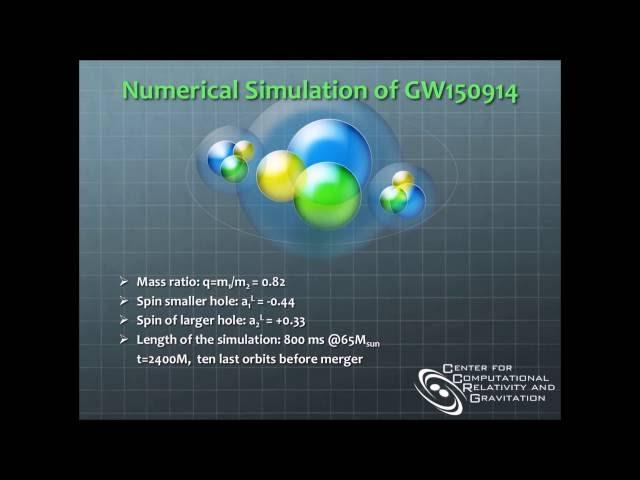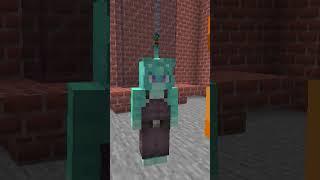
Numerical Simulation of GW150914
This visualization of a full numerical simulation of GW150914 [1]
has the parameters of mass ratio q=m1/m2=0.82 and intrinsic spins a1=-0.44 and a2=+0.33 as described in [2]. Displayed first are the apparent horizon of the two black holes with color a map corresponding to its mean curvature [3] on a curved background given by the lapse function. In later frames, with the further away perspective, the background is changed into gravitational waves as described by the Weyl scalar psi4 [4]. The final frames show the merger of the two horizons into one and the settling of the final black hole into a single, nonradiating, stationary Kerr hole [5].
References:
===========
[1] B~P.Abbott et al. [LIGO Scientific and Virgo Collaborations], ``Observation of Gravitational Waves from a Binary Black Hole Merger,''
Phys. Rev. Lett. 116, no. 6, 061102 (2016). [arXiv:1602.03837 [gr-qc]].
[2] G.Lovelace et al., ``Modeling the source of GW150914 with targeted numerical-relativity simulations,'' [arXiv:1607.05377 [gr-qc]].
[3] J.Thornburg,
``Event and apparent horizon finders for 3+1 numerical relativity,''
Living Rev. Rel. 10, 3 (2007). [gr-qc/0512169].
[4] M.Campanelli, B.J.Kelly and C.O.Lousto, ``The Lazarus project. II. Space-like extraction with the quasi-Kinnersley tetrad,'' Phys. Rev. D 73, 064005 (2006). [gr-qc/0510122].
[5] M.Campanelli, C.O.Lousto and Y.Zlochower, ``Algebraic Classification of Numerical Spacetimes and Black-Hole-Binary Remnants,'' Phys. Rev. D 79, 084012 (2009). [arXiv:0811.3006 [gr-qc]].
has the parameters of mass ratio q=m1/m2=0.82 and intrinsic spins a1=-0.44 and a2=+0.33 as described in [2]. Displayed first are the apparent horizon of the two black holes with color a map corresponding to its mean curvature [3] on a curved background given by the lapse function. In later frames, with the further away perspective, the background is changed into gravitational waves as described by the Weyl scalar psi4 [4]. The final frames show the merger of the two horizons into one and the settling of the final black hole into a single, nonradiating, stationary Kerr hole [5].
References:
===========
[1] B~P.Abbott et al. [LIGO Scientific and Virgo Collaborations], ``Observation of Gravitational Waves from a Binary Black Hole Merger,''
Phys. Rev. Lett. 116, no. 6, 061102 (2016). [arXiv:1602.03837 [gr-qc]].
[2] G.Lovelace et al., ``Modeling the source of GW150914 with targeted numerical-relativity simulations,'' [arXiv:1607.05377 [gr-qc]].
[3] J.Thornburg,
``Event and apparent horizon finders for 3+1 numerical relativity,''
Living Rev. Rel. 10, 3 (2007). [gr-qc/0512169].
[4] M.Campanelli, B.J.Kelly and C.O.Lousto, ``The Lazarus project. II. Space-like extraction with the quasi-Kinnersley tetrad,'' Phys. Rev. D 73, 064005 (2006). [gr-qc/0510122].
[5] M.Campanelli, C.O.Lousto and Y.Zlochower, ``Algebraic Classification of Numerical Spacetimes and Black-Hole-Binary Remnants,'' Phys. Rev. D 79, 084012 (2009). [arXiv:0811.3006 [gr-qc]].
Комментарии:
Обзор Volkswagen Tiguan
Ильдар Live
Numerical Simulation of GW150914
Center For Computational Relativity and Gravitation
Genshin: Star Rail
Crying Aqua
Goodbye Kilo | Blox Fruits animation
dm_animation
Про орден Мужества
Лохпожизни
ROZHDEN - Пустяк (караоке) инструментал
Daria Tanner
jus know - dave and bambi animation meme
bendedkeyboard


























